The birthplace of Western civilization and one of Europe’s most vibrant contemporary capitals, the immortal city of Athens suffers no shortage of appeal to thrill its millions of visitors. Besides its own prestige, however, Athens boasts a strategic position at the core of one of the world’s most historic and scenic countries. Given Greece’s small size and robust transport infrastructure, the possibilities of speedy, delightful excursions away from the Athenian urban jungle are virtually endless. If you have more than a couple of days to spare in Athens, seize the opportunity to venture out and explore Greece’s captivating countryside. In my capacity as an occasional tour guide—during periods I am in Athens—here I share my top ten destinations for day trips out of Athens, where I most frequently take my clients.
You can visit all the listed destinations either by joining an organized tour or independently, by renting a car or utilizing public transport. For each destination, I provide both recommended tours and basic how-to-get-to-on-your-own information, as well as links to useful further reading.
Affiliation disclosure: By purchasing goods or services via the links contained in this post, I may be earning a small commission from the seller's profit, without you being charged any extra penny. You will be thus greatly helping me to maintain and keep enriching this website. Thanks!
Browse more tours and activities on GetYourGuide:
If you’re interested in renting a car, you can search for good deals here:
If you’re still looking for accommodation in Athens or elsewhere, I can’t recommend enough this tool:
Stay22 is a handy tool that lets you search for and compare stays and experiences across multiple platforms on the same neat, interactive map. Hover over the listings to see the details. Click on the top-right settings icon to adjust your preferences; switch between hotels, experiences, or restaurants; and activate clever map overlays displaying information like transit lines or concentrations of sights. Click on the Show List button for the listings to appear in a list format. Booking via this map, I will be earning a small cut of the platform's profit without you being charged any extra penny. You will be thus greatly helping me to maintain and keep enriching this website. Thanks!
Nafplion & Mycenae
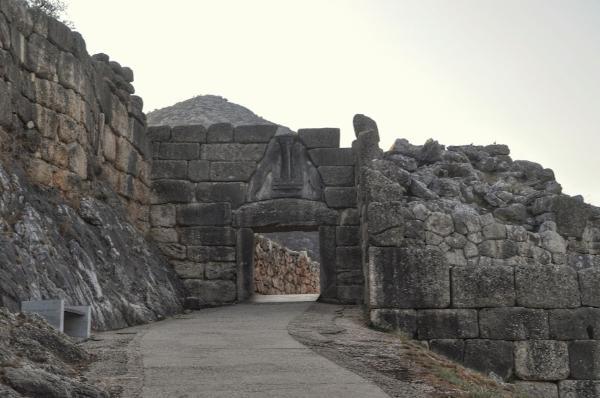
This trip combines a lovely contemporary town with one of Greece’s most important archeological sites situated close to each other.
Nafplion is a small coastal town 140 km from Athens. It is primarily known for having served as the first capital city of the modern Greek state between 1829 and 1834. Endowed by its rich history, the old town features some really picturesque, colorful neoclassical architecture. The houses’ characteristic balconies often uphold bougainvilleas, jasmines, and other vibrant plants hanging over and shading the stone-paved streets. The town is crowned by a Venetian medieval fortress standing atop a massive rock known as Palamidi, from where you can marvel at a stunning view of the Argolic Gulf and the surrounding mountains. A smaller Venetian sea fort embellishes the entrance to the town’s port. Nafplion is also blessed with several beautiful beaches that you could take advantage of.
The archeological site of Mycenae is located 24 km away from Nafplion along the way to Athens. This timeless city that was ancient for the ancient Greeks has given its name to an entire civilization and the era associated with it. If not from history books, you must surely have heard of it from the blockbuster Troy among countless other films recounting the events of the Trojan Wars, which we all ultimately know about from Homer’s celebrated epics. Despite being depopulated for more than three millennia, the cyclopean city of Mycynae is preserved in an admirably good condition. Exploring its immortal grounds is sure to leave you in awe of the unfathomability of human existence.
You have plenty of options for private or group day tours combining these two destinations. The drive from Athens to Nafplion takes about two hours each way. It’s also possible to do it by public transport, albeit a bit marginally. Buses from Athens to Nafplion depart from Kifissos Terminal and take nearly three hours. You would then have to get a taxi or hitchhike from Nafplion to Mycenae and catch the return bus from the nearby Fichti Village. Here is the timetable. If you have a private vehicle, a day trip to Nafplion and Mycenae could additionally be combined with visits to more of the many archeological wonders in the area such as Tiryns, Nemea, Lerna, and Argos.
Here is a story with photos from one of my own tours in the region:
Athens to Mycenae, Tiryns, and more – driving day trip
Aegina
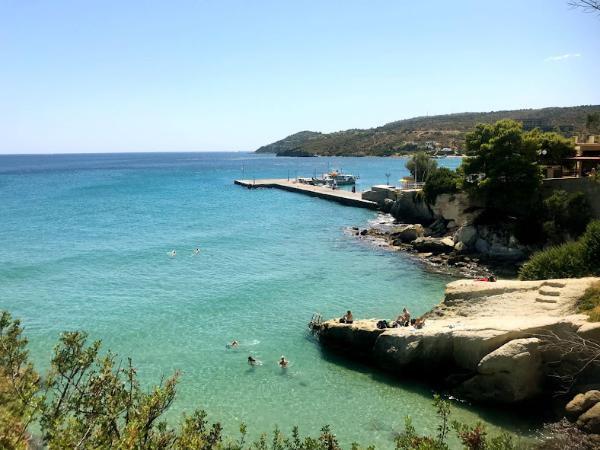
If you’re on a short trip to Greece and lack the time to visit some of the world-famous Greek islands in the Cycladic Archipelago and beyond, the Saronic Gulf is ideal for express maritime getaways. All the rest of the Saronic Islands (Salamina, Agistri, Poros, Hydra, Spetses) also make for excellent day trip destinations. I feature Aegina because it’s big and proximate, offering better exploration possibilities.
Aegina boasts a multitude of beautiful, clear beaches perfect for a dip and a superb seafood meal by the splashing waves. Agia Marina and Marathonas are two of the most popular choices. Moreover, the island comprises several picturesque villages and historic sites such as the ancient Temple of Aphaia and the Monastery of Saint Nektarios. What Aegina is most famous for is its unique variety of pistachios, exported worldwide and considered one of the world’s finest.
You can visit Aegina either by joining an organized boat tour or on your own by ferry. Besides its ease, the former choice has the additional benefit of allowing you to discover some wonderful, secluded spots around the island’s periphery, as well as often combining more nearby islands. If you prefer to visit on your own, you catch the ferry from Gate E3 at Piraeus Port. The trip takes roughly one hour each way. Here you can check the timetable and book tickets. Then you can move around the island by public buses or renting a car or scooter.
Here is a story with photos from one of my own day trips to Aegina:
A Day Trip from Athens to Aegina Island and Agia Marina Beach
Cape Sounion
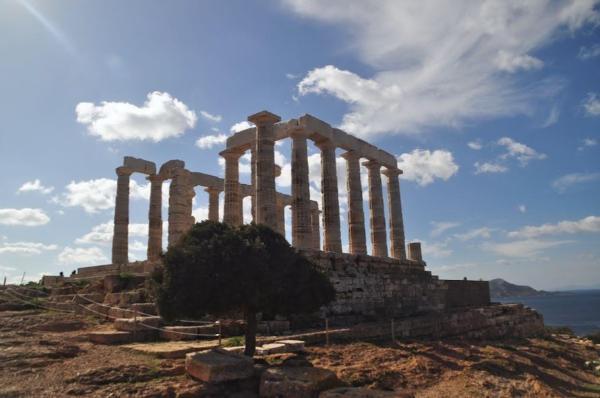
Due to its significance, beauty, and proximity, Cape Sounion is likely the single most popular day trip destination from Athens. Situated at the promontory of the Attic Peninsula, 70 km south of Athens, the site features a captivating ancient temple that looks out on the vast Aegean Sea over a 60-meter perpendicular cliff. Constructed in the mid-5th century BC, during the heyday of Athens’ Golden Age, the magnificent Temple of Poseidon stands as one of the finest examples of classical architecture, earning Sounion its alternate name of Capo Colonne. The sun plunging into the blue immensity behind the temple’s timeworn, venerated columns creates one of Greece’s most emblematic images.
Besides Poseidon’s temple, the archeological site of Sounion preserves remnants of an ancient fort and another temple dedicated to Athena. A cafe/restaurant with a fantastic view stands by the entrance. A day trip to Sounion can be enhanced by time at one of several lovely beaches en route, as well as a visit to additional interesting places like Vouliagmeni Lake and—my most recommended option on my own tours to Sounion that few know about—the mysterious cave of Vari.
Besides having the greatest variety of organized tour options, Cape Sounion is one of the easiest of the listed destinations to reach by yourself using public transport. The buses to Sounion depart from the Mavromateon bus stop, located by the main entrance of Pedion Areos Park, near Victoria Metro Station. The one-way trip takes about one and a half hours. The routes are limited; you’ll have to plan in advance. Here’s the timetable.
Delphi
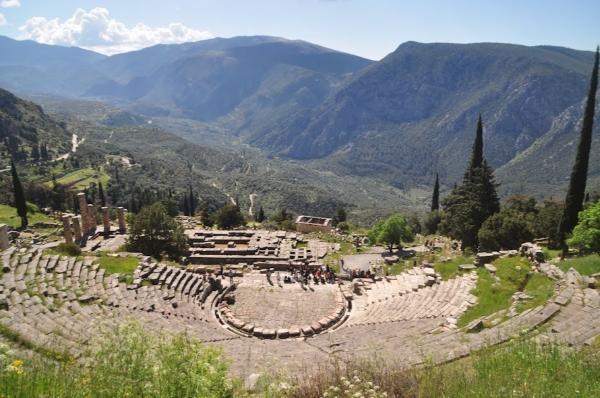
If there is any place that deserves the title of the ancient world’s most sacred site, that’s unquestionably Delphi. Nestled in a deep gorge at the foot of Mount Parnassus, there stood the glorious Temple of Apollo that housed Pythia, the great Oracle of Delphi. Essentially, she was a long succession of priestesses who were getting high on whatever hallucinogenic substance was referred to as the “trance-inducing, holy fumes rising from a chasm beneath the temple” and influenced the fate of humanity by delivering prophecies to kings, generals, and all sorts of powerful pilgrims who journeyed to her from all corners of the known world for more than a thousand years. Her influence has endured into our age, encapsulated in the now-cliché “know thyself” aphorism that was inscribed at her temple’s entrance.
Besides the remnants of Apollo’s temple, the archeological site of Delphi comprises a theater, a stadium, many treasuries, and a plethora of other ruins and relics in the local museum. On the way to Delphi, you can stop and check out Livadeia town and the mountain village of Arachova, which serves as the base camp for southern Greece’s largest ski center. Additionally, you may combine a trip to Delphi with a trek on Mount Parnassus (the Corycian Cave is a good, close destination for a day trip) or a visit to the Corinthian Gulf towns of Itea and Galaxidi.
Again, you can find many organized day tours to Delphi and you can also make it on your own by public transport. Buses to Delphi depart from Liossion Terminal and take about two and a half hours one-way.
Mount Parnitha

Parnitha is the highest of the three main mountains enclosing the basin of Athens and comprises the largest national park in the Attica region. Although it has suffered several massive wildfires in recent decades, it also remains the greenest area near Athens. Dense conifer forest still covers extensive portions of the mountain, particularly on its northern slopes. For most of the winter, it is coated with an ample layer of snow, forming a contrasting landscape to the sunlit beaches typically associated with Greece. Mount Parnitha is also one of only two reserves (the other being the Rhodope Mountains far north on the Bulgarian border) for the endangered red deer, with an estimated population of 700.
A short drive away from downtown Athens, Mount Parnitha is an ideal day trip destination for hikers and nature lovers. It features a vast network of trails passing through diverse terrains like woods, open plateaus, gorges, and spectacular viewpoints. Mind that the summit itself (1,413 meters) hosts a military base and is restricted. Besides stunning nature, you can see various historical sights such as the ancient castle of Fylli, the abandoned ex-royal palace of Tatoi, and several monasteries and old churches. And except for hiking, you can indulge in additional activities like rock climbing, mountain biking, and skiing (as long as you climb a slope by yourself—no lifts). If sports isn’t your thing, you can still enjoy a ride up the mountain and a drink at its cozy mountain shelter.
While not your common touristy site, there are a few organized hiking tours to Mount Parnitha (myself doing one during periods I am in Athens). But if you prefer being an independent explorer, it’s fairly easy to reach the mountain by public transport and hit the trail on your own.
You can find out more information about buses and trails in this detailed post:
Hiking Mount Parnitha National Park near Athens
Corinth
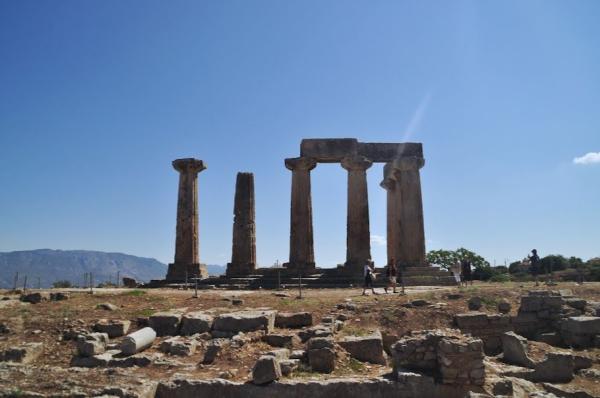
The modern city of Corinth stands at the gateway to the Peloponnese, some 80 km west of Athens. It is a smallish, laid-back, yet lively city featuring many cute cafes and restaurants and a long, sandy beach dominated by a view of towering mountains across the gulf. The principal reason to visit the area, however, is the ancient city of Corinth. Noted among ancient Greeks for its marvelous riches and profligate extravagance, its remnants now constitute one of the most important archeological sites in Greece. In its broad grounds, it encompasses plenty of well-preserved monuments, most notable of which are the Temple of Apollo, the Agora, and the Bema of Apostle Paul where he stood his famous trial. Additional ancient structures and posterior, medieval fortifications stand atop the tremendous rock known as the Acrocorinth that soars above the ancient city.
During this day trip, you should definitely stop at the Isthmus of Corinth to wonder at the ships passing through its emblematic canal. Additionally, you can combine it with a visit to the nearby holiday town of Loutraki and other beaches and villages along the northern coast of the Saronic Gulf.
Besides a wide range of organized tour offers, you have access to frequent buses and trains going to Corinth. Buses leave from Kifissos Terminal and trains from Larissa Station. Both take about an hour each way.
Chalkida
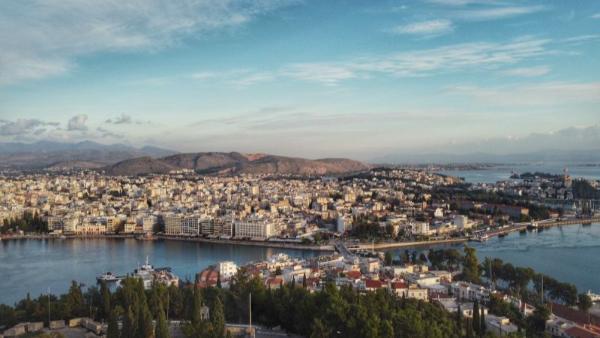
Chalkida is the capital city of Evia: Greece’s second-largest island that is connected to the mainland by two bridges. The city is most famous for the unique natural phenomenon that occurs in the strait spanned by the smaller bridge—in which a tidal current streams like a powerful river and switches direction every six hours—which gives the city its sobriquet of crazy waters. According to one of several relevant theories, this is where Aristotle died, drowning in the current while attempting to study it. Moreover, Chalkida offers various historical sights, several nice beaches within the city itself, gorgeous views of the surrounding bay, and a lively waterfront promenade full of cafes, bars, and some of the best seafood taverns anywhere near Athens.
Being a mere hour away from Athens, a day trip to Chalkida allows for endless possibilities for further exploration of central Evia Island. From remote beaches to alpine landscapes, and from ancient ruins to picturesque villages, the place is a treasure cove for the unconventional traveler. When I’m in Greece side-gigging as a tour guide, Chalkida is my most recommended destination as it also happens to be my beloved hometown.
Despite its beauty and proximity to Athens, Chalkida and its periphery have not yet become popular with the tourist masses, which is another advantage if you wish to experience a more authentic side of Greece. Organized tours in that direction are rather limited, but there are sure a few. Regardless, Chalkida is especially easy to reach on your own by public transport. Buses start from Liossion Terminal and trains from Larissa Station. Both are very frequent and take about an hour. The train is the better option as it drops you off right in the city center.
Check out this for more details on how to get to Chalkida or various other parts of Evia:
How to get to Evia Island (Euboea) in Greece
This for more inspiration for what to do in Chalkida:
12 Top Things to do in Chalkida, Greece
And this for more on Evia Island in general:
Evia Island Travel Blog
Epidauros
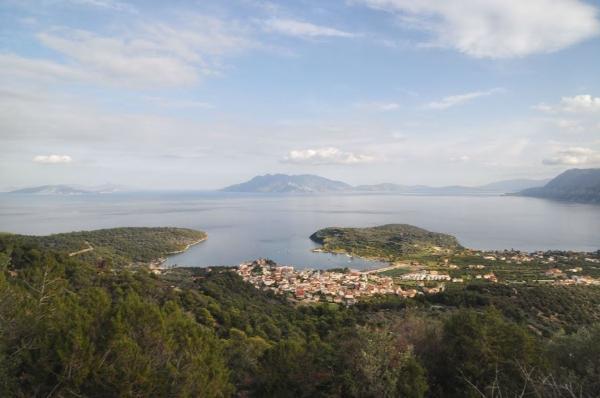
Owing to its plentiful mineral springs, Epidauros evolved into antiquity’s most renowned healing sanctuary. As a result, it also became the principal hub of the Cult of Asclepius: the Greek god of medicine who was always represented holding a staff with a snake coiled around it, which you may know as the contemporary symbol of medical science. Patients from all over the Mediterranean used to travel there and lay their hopes on the mythical divine healer and the world’s best physicians that his sanctuary attracted.
Today, Epidauros is one of Greece’s most important archeological sites. Among various remains, it comprises the Temple of Asclepius and a theater, which is regarded as the ancient world’s most splendid theater in terms of aesthetics and acoustics. The nearby town of Old Epidauros is an agreeable place for a stroll and a meal by its picturesque bay. The general area is also conducive to pleasant hikes.
It takes roughly two hours to reach Epidauros by bus from Athens. There is a profusion of tours on offer visiting Epidauros either over land or, in some cases, by boat. Alternatively, it’s also possible to undertake the trip by bus. There is usually one morning route leaving from Kifissos Terminal and one return route in the evening. Here is the timetable.
Meteora
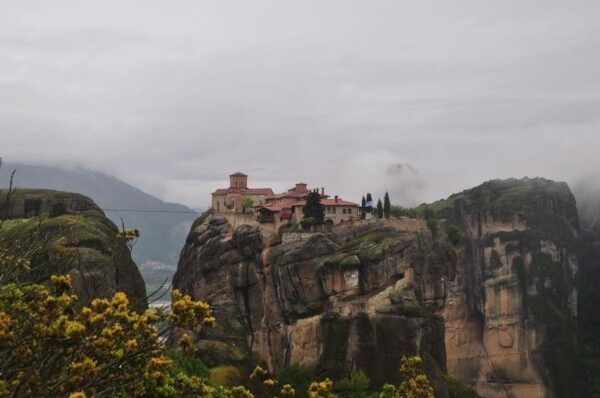
A one-of-a-kind geological formation, the Meteora is a bunch of granite rock pillars towering perpendicularly, some for over 600 meters, from the plains of Thessaly in northern Greece. Even more than for its unparalleled natural allure, the place is renowned for its cultural heritage. The rock tops host a cluster of monasteries that, hanging over the treacherous cliff edges, constitute an architectural marvel and a paradigm of seclusion. Out of the original twenty-four monasteries established in the late Middle Ages, six continue to operate today and receive visitors.
With their timeworn buildings and charming gardens amid this most astounding landscape, the monasteries of Meteora offer some really extraordinary photographic opportunities. Plentiful hiking trails span the area and lead to additional, hidden monastic structures and fascinating viewpoints. Kalabaka, the gateway town to the monasteries, has many good restaurants below the view of the massive rocks.
The Meteora is indeed a world-famous destination, ranked among the top places to visit in all Greece. The only reason I don’t feature it higher in this list is that it’s far from Athens. I always recommend to people to allocate at least a couple of days for it if possible at all. But if you absolutely have to, it is still doable on a day trip, either by joining an organized tour or even by public transport. Either way, be prepared to spend a good part of your day on the road. The back-and-forth trip will take a minimum of eight hours. Especially if you decide in favor of public transport, you’ll have very limited time to explore and you’ll need to take a taxi to the monasteries. You can either catch a train or a bus to Kalabaka from Larissa Station or Liossion Terminal respectively. You’ll have to start at dawn and return in the evening. Here are the timetables for the train and the bus.
Dragon Houses of Mount Ochi
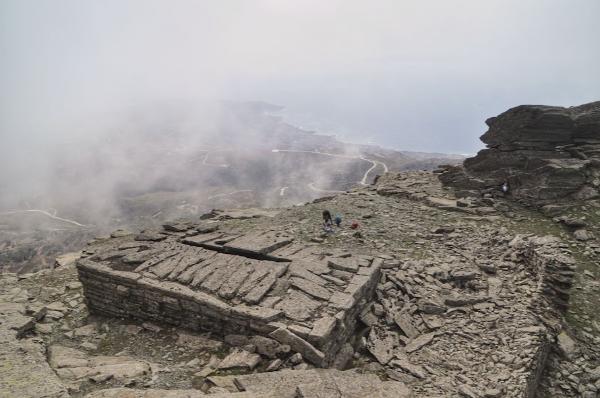
Mount Ochi is a prominent mountain on the southern tip of Evia Island, just east across the gulf from Athens. Apart from its imposingness and natural grace, the mountain is renowned for a number of enigmatic structures scattered throughout its slopes known as the Dragon Houses. Their construction technique of Cyclopean masonry (stacking large blocks without mortar) suggests a prehistoric origin, but archeologists haven’t figured out either their dating or their purpose. The biggest and most impressive of the Dragon houses stands on the very top of the mountain.
Consider this last addition to the list as a sort of bonus. The Dragon Houses of Ochi remain far from the realm of popular tourist destinations, being visited sporadically by archeology and mystery enthusiasts. There are a handful of agencies organizing tours locally, but no one offering day trips from Athens as far as I’m aware. That is, except for myself. If you are interested, and I happen to be in Athens and available during your visit, I could take you up there in one day from Athens. Feel free to inquire.
Otherwise, you can do it by yourself only if you have a car. You’ll have to catch the morning ferry from Rafina to Marmari, drive near the mountain top, hike up and down for 3–5 hours, and be back before the last return ferry.
You can find more information about the ferries here:
How to get to Evia Island (Euboea) in Greece
And more information about the whole trip in this example of one of my own tours there:
Dragon Houses (Drakospita) of Evia Island in one day from Athens
